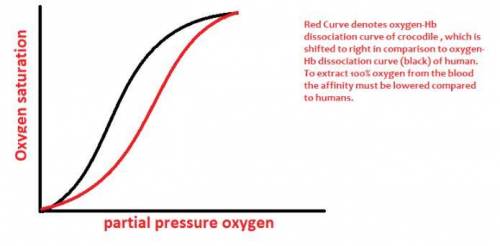
Chemistry, 15.02.2021 20:20 princessroyal
The crocodile which can remain underwater without breathing for up to an hour, drowns it air-breathing prey and then dines on them at its leisure. An adaptation that aids the crocodile in doing so is that it can utilize virtually 100% of the O2 in its blood whereas humans, for example, can extract only -65% of the O2 in their blood. (a) Draw an O2 binding curve comparing crocodile hemoglobin to that of normal hemoglobin. humne ih (b) Experiments have demonstrated that 2,3 bis-phosphoglycerate has no effect on the O2 binding of crocodile hemoglobin. However, it has been shown that 2 molecules of bicarbonate bind to deoxyhemoglobin tetramers but not to oxyhemoglobin tetramers of crocodile hemoglobin. Describe how bicarbonate might effect the O2 affinity of crocodile hemoglobin. Make sure to detail what regions of the hemoglobin tetramek might be bound by bicarbonate and how this would influence structural changes in the crocodile hemoglobin that would, in turn, affect O2 affinity. (c) Sketch the biochemical reactions in red blood cells that result in bicarbonate formation in venous blood. Write balanced equations and identify any enzymes that might be involved. If an enzyme is required, indicate which reaction is enzyme-catalyzed.

Answers: 1


Another question on Chemistry

Chemistry, 22.06.2019 01:00
Which part of a feedback mechanism is able to monitor the conditions outside of cells and usually uses nerve cells to relay this information to an intergrating center
Answers: 2

Chemistry, 22.06.2019 18:00
An object displaces 652 ml of water. the volume of the object is: 0.652 cm³ 6.52 cm³ 65.2 cm³ 652 cm³
Answers: 3

Chemistry, 22.06.2019 18:00
How is energy related to the change of state represented by the model? atoms gain energy as a solid changes to a liquid. atoms gain energy as a solid changes to a gas. atoms lose energy as a solid changes to a liquid. atoms lose energy as a solid changes to a gas.
Answers: 3

Chemistry, 22.06.2019 23:30
Imagine a small synthetic vesicle made from pure phospholipids enclosing an interior lumen containing 1 mm glucose and 1 mm sodium chloride. if the vesicle is placed in pure water, which of the following happens faster? a. na+ diffuses out. b. cl– diffuses out. c. h2o diffuses in. d. glucose diffuses out. e. sodium chloride diffuses out.
Answers: 3
You know the right answer?
The crocodile which can remain underwater without breathing for up to an hour, drowns it air-breathi...
Questions

Mathematics, 14.12.2021 01:20

Mathematics, 14.12.2021 01:20

Mathematics, 14.12.2021 01:20


SAT, 14.12.2021 01:20


History, 14.12.2021 01:20

History, 14.12.2021 01:20


SAT, 14.12.2021 01:20


Chemistry, 14.12.2021 01:20



Mathematics, 14.12.2021 01:20



History, 14.12.2021 01:20





